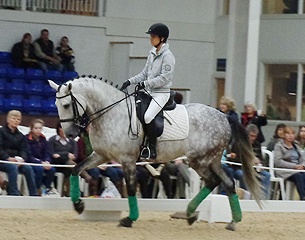
The movements that we carry out in competition are designed to be executed with precision, engagement, balance and rhythm. We should aim to start the half pass at X and finish it at H, and there should be no variation in the speed, balance, cadence or angle within the movement. Training at home is very different, and while we may occasionally test to see if we can perform the perfect half pass or shoulder-in, in training it should be used as a tool to provide us with information and to increase the strength and gymnastic ability of our horse.
My trainer Miguel Ralao often tells me to “play with the gears,” meaning that he wants me to vary certain elements within the half pass to test and improve the co-ordination of my aids and my horse's response to them. Instead of starting the half pass and then sitting on top like a dead duck hoping that the horse maintains the same rhythm and balance, the key to effective training is in the rider’s ability to control and alter the degree or the speed or the engagement of the horse, within the exercise, at any given moment.
This means that when you enter the half pass, you say to yourself, “if I ask for a bit longer stride, can I achieve that without losing the angle, can I increase the bend slightly without losing the quarters? Can I go on four strides, and then come back four strides, while maintaining an elastic connection to my horses mouth, or does my horse come off the bit, above the bit, below the bit, behind my leg, or lose the angle of the half pass?"
Before attempting this you must of course be able to test the gears on the straight or curved lines before you introduce this test in lateral movements. Can you go on and come back for four strides and actually make it four strides, or do you go on, get to four strides and realise oh crap he’s not responding, and then make it five so it seemed as though you had the control after all?
Testing the gears allows you to determined if your horse is on the aids, but again it must be on your terms and not on his, and if you ask for a more forward canter and three strides later he gives it to you, then there is no point trying the same aid within a half=pass or shoulder-in. You must first ensure that when you give a leg aid, you get a response and if you don’t then you need to ask if your horse is listening to you, or just having a nice trek around the arena on his own terms.
Controlling your horse on a straight line is fantastic, but controlling your horse before during and after each exercise, is something entirely different. This technical control begins even before you begin an exercise, and when you begin the half-pass does he swing his quarters and get in ahead of you, or do you control the movement from the beginning?
Test it. Start a half pass with just bend and then introduce the quarters four strides in. Does your horse swing all over the place in confusion, or does he start in correct bend and without altering his rhythm or balance gently bring his quarters into play?
My coach then often advises me to begin the half pass and then try going on for four strides and then coming back four strides, making sure that I am in control and Batialo doesn’t get behind my leg or behind the bit.
In the shoulder-in the same, and taking the three quarter line (so I know I have the control of the outside shoulder and I’m not relying on the “straightener” ) I increase the lift, I allow a little with the outside rein to see if that helps to create more shoulder freedom on the outside fore, or I ask a little more bend and make sure that I can maintain the engagement of the inside hind. I increase the cadence and try to maintain the angle, and then I decrease the cadence while making sure Batialo stays through and forward.
The rider’s ability to control their horse and then use that control to vary the expression and cadence of the horse within exercises, is what defines a top combination from an average one.
In the test, a horse and rider that have trained their horse to respond well to the aids throughout the entire exercise, will have a horse always asking “what does my rider want”, instead of a horse that says, “Oh a half pass, I’ll just takeover here and fly across to the other side."
Once you have a horse that is always asking “what’s up," you have a horse that you know is with you, listening to you, and working with, instead of ahead of you, with every step.
by Sarah Warne for Eurodressage
Read all of Sarah's Classical Training Articles here.